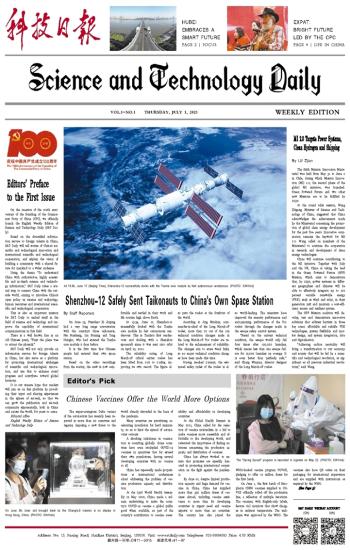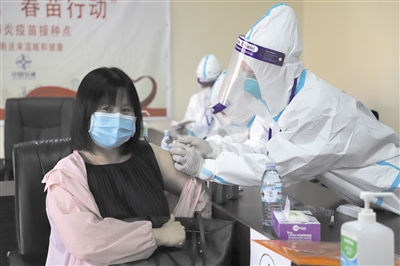
 Hubei Embraces a Smart Future
Hubei Embraces a Smart Future Expat Sings of the Bright Future Led by the CPC
Expat Sings of the Bright Future Led by the CPC Shenzhou-12 Safely Sent Taikonauts to China's Own Space Station
Shenzhou-12 Safely Sent Taikonauts to China's Own Space Station MI 2.0 Targets Power Systems, Clean Hydrogen and Shipping
MI 2.0 Targets Power Systems, Clean Hydrogen and Shipping Editors' Preface to the First Issue
Editors' Preface to the First Issue Chinese Vaccines Offer the World More Options
Chinese Vaccines Offer the World More Options S&T DAILY WECHAT ACCOUNT
S&T DAILY WECHAT ACCOUNT PHOTO NEWS
PHOTO NEWS
 |
| The "Spring Sprout" program is launched in Uganda on May 22. (PHOTO: XINHUA) |
The super-contagious Delta variant of the coronavirus has recently been reported in more than 90 countries and regions, imposing a new threat to the world already shrouded in the haze of the pandemic.
Many countries are prioritizing accelerating inoculation for herd immunity, so as to limit the spread of coronavirus variants.
A shocking imbalance in vaccination is occurring globally. Some countries have even stockpiled COVID-19 vaccines in quantities that far exceed their own populations, leaving several developing countries with no vaccine at all.
China has repeatedly made propositions at international conferences about addressing the problem of vaccine production capacity and distribution.
At the 73rd World Health Assembly in May 2020, China made a solemn undertaking to make the country's COVID-19 vaccine a global public good when available, as part of the country's contribution to vaccine accessibility and affordability in developing countries.
At the Global Health Summit in May 2021, China called for the rejection of vaccine nationalism in a bid to make vaccines more accessible and affordable to the developing world, and reiterated the importance of finding solutions concerning the production capacity and distribution of vaccines.
China has always worked to ensure that promises are speedily honored in promoting international cooperation on the fight against the pandemic.
By June 22, despite limited production capacity and huge demand for vaccine in China, China has supplied more than 350 million doses of vaccines abroad, including vaccine assistance to more than 80 developing countries in urgent need and vaccine exports to more than 40 countries. The country has also joined the WHO-backed vaccine program COVAX, pledging to offer 10 million doses for the first batch.
On June 1, the first batch of Sinopharm CNBG vaccines supplied to COVAX officially rolled off the production line, a reflection of multiple iterations. The vaccines, with English-only labels, feature vial monitors that show changes in ambient temperature. The technique was approved by the WHO. The vaccines also have QR codes on their packaging for international supervision and are supplied with instructions as required by the WHO.
On the same day, the WHO validated an inactivated COVID-19 vaccine called CoronaVac, developed by Sinovac R&D, a subsidiary of Sinovac Biotech, for emergency use. CoronaVac, coupled with previously certified BBIBP-CorV developed by Sinopharm CNBG, is bringing hope to alleviating the unfair distribution of vaccines around the globe.
To ease tight vaccine supplies to a larger extent, Chinese vaccine companies are speeding up to carry out authorized production and joint research with capable countries.
At the end of March, liquid bottles of inactivated COVID-19 vaccine rolled off the production line at a liquid filling & packaging production workshop jointly built by Sinopharm CNBG and the G42 Group in the United Arab Emirates.
In terms of the effectiveness evaluation and authorized production of the COVID-19 vaccine, Sinovac has also carried out fruitful cooperation with its Brazilian partners. For example, the vaccine has been proved safe and effective in the Phase III clinical trials carried out among 12,000 medical staff; Plan S for real-world research has been implemented in the small town of Serrana in Sao Paulo; and localized production of the COVID-19 vaccine has been achieved through licensed production.
''In response to the huge vaccine demand, in addition to providing finished products, we have also exported semi-finished jabs to some countries and authorized local filling and packaging,'' said Yin Weidong, Chairman of Sinovac Biotech.
Yin Countinued saying: "Our core aim is to make the vaccine rapidly available in these countries, increase their vaccination rate and reducing the incidence as soon as possible. We expect more countries to participate in the authorized local production mode, which is the most direct and effective way for quickly improving vaccine production capacity and ensuring vaccine supply.''
By June 22, three Chinese vaccine manufacturers have carried out joint production with eight countries, and they are also discussing cooperative production plans with 10 additional countries, according to Mao Junfeng, Deputy Director of the Consumer Products Industry Department of the Ministry of Industry and Information Technology.
In the future, China will continue to propel the technology transfer of its vaccine makers to more developing countries and support them in carrying out international capacity cooperation.
Over the past year or so, the recurrent outbreaks of the pandemic are a reminder that humanity rises and falls together with a shared destiny and a shared future.
As the safety, effectiveness, and convenience of Chinese vaccines have been fully proven, China, bearing the situation and needs of developing countries in mind, has been taking concrete actions to promote a fair and reasonable distribution of vaccines and bring more choices to the world.
Source: Xinhua

 Next
Next



